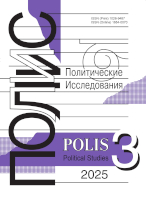The 2012-2014 Party Reform and the Structure of the Electoral Divides in Russia’s Regions
Korgunyuk Yu.G.,
Dr. Sci. (Pol. Sci.), Leading Researcher, INION RAN, partinform@mail.ru
elibrary_id: 36510894 |
DOI: 10.17976/jpps/2015.04.09
Korgunyuk Yu.G. The 2012-2014 Party Reform and the Structure of the Electoral Divides in Russia’s Regions. – Polis. Political Studies. 2015. No. 4. https://doi.org/10.17976/jpps/2015.04.09
The article analyses the results of elections to regional assemblies by the proportional system in Russia in 2012‑2014 from the point of view of the concept of electoral and political cleavages, which author has developed in his previous works. The author proposes methods for solving problems which appear because of not-coinciding number of contestants in various regions – this generates a different structure of electoral and political cleavages in there. The author also traces how the ‘party reform’ of 2012‑14 has influenced the cleavage structure in Russian regions. He concludes that proponents of the reform reached their aim if they wanted to confuse voters, because the increasing number of contestants multiplied political dimensions and, as a consequence, increased a number of electoral cleavages. Higher level of political competition in some regions was conditioned not by the appearance of new actors but by weakening of the administrative pressure on voters. Author also argues that stricter requirements for contestants in 2014 have led to decreasing number of electoral and, especially, political cleavages, but Russian regions, as before, are divided into two groups: those where authorities continue to control hard the electoral process and those where weakening of this control have brought inter-clan conflicts to the fore.
See also:
Korgunyuk Yu.G.,
Cleavage Theory and Theory of Issue Dimensions: Cross-Points. – Polis. Political Studies. 2019. No6
Smorgunov L.V.,
Network political parties. – Polis. Political Studies. 2014. No4
Gelman V.Ya.,
Political Parties in Russia: from Competition – to Hierarchy. – Polis. Political Studies. 2008. No5
Kudryashova I.V., Kozintsev A.S.,
Revisiting cleavage structures: Islamic parties and nation-state formation in the Arab world. – Polis. Political Studies. 2023. No3
Suvakovic U.,
Political parties as traditional mechanisms of representation in modern societies. – Polis. Political Studies. 2010. No2





.jpg)






 print
print
.jpg)
.jpg)